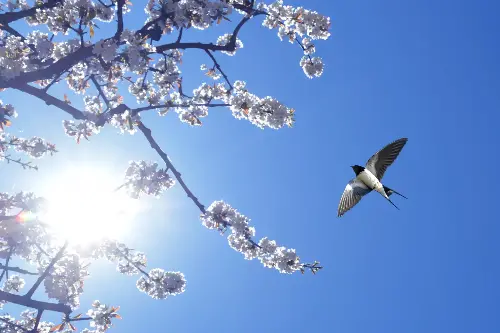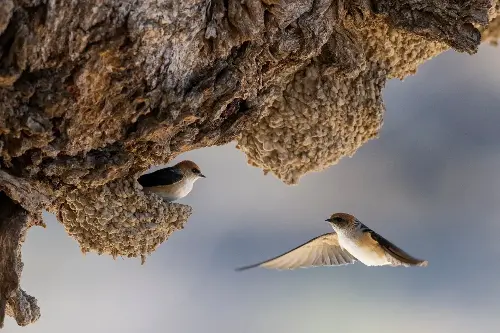With the arrival of warmer breezes and the subtle lengthening of days, one of nature's most delightful heralds makes a much-anticipated appearance in our skies—the swallow. These agile and spirited creatures have intrigued and inspired onlookers for centuries, symbolising the resurgence of life, hope, and the promise of growth as they expertly dance through the springtime air. In this exploration of our aerial acrobats, we'll delve into the fascinating role of swallows in our ecosystems and the cultural significance they carry as messengers of the changing seasons.

The Swallow's Journey: A Feat of Endurance and Precision
Swallows are remarkable not only for their graceful flight patterns but also for their extensive migratory journeys. These birds travel thousands of miles from their wintering grounds in Africa to grace British and European skies with their presence every spring. The return of the swallows is a feat of endurance and precision, following ancestral routes that span multiple generations. Their timely arrival is a testament to their resilience and an ever-reliable signal that spring is truly upon us.
The sight of swallows swooping and diving through the air as they hunt insects on the wing is not just a display of mastery in flight. It's a crucial ecological function. These birds play a vital role in controlling insect populations, thereby contributing to the balance of our local ecosystems. A single swallow can consume hundreds of insects a day, making them a natural and welcome pest control agent as the earth thaws and bug populations begin to boom.
Cultural Icons: The Swallow in Art and Literature
Swallows have not only caught the attention of naturalists but also sparked the imaginations of poets, artists, and storytellers throughout history. They are emblematic of the change in seasons, often depicted in literature and folklore as omens of good fortune or as symbols of fidelity and love, owing to their tendency to return to the same nesting sites each year.
The swallow's return has been celebrated in verse by the likes of John Clare and William Wordsworth, and in prose across various cultures. In Greek mythology, the transformation of the princess Philomela into a swallow is a tale of transformation and rebirth, further aligning these birds with themes of renewal.

Nesting Habits: A Swallow's Homecoming
As part of their springtime rituals, swallows exhibit fascinating nesting behaviours. They typically seek out nooks and crannies in rural and urban settings alike, building their nests with pellets of mud mixed with grass. These structures are often found under eaves, inside old sheds, or even on ledges inside buildings, bringing the magic of nature directly to our doorsteps.
The nest-building process is a communal affair, with pairs or even groups working in tandem to establish their homes. This also presents an opportunity for nature lovers to witness the resourcefulness of swallows first-hand. With the revival of construction, you can observe these tiny architects at work, meticulously crafting their summer residences.
Environmental Indicators: Swallows as Barometers of Ecological Health
Swallows, due to their insectivorous diets and migratory patterns, are sensitive to changes in climate and landscape. Their fluctuating numbers can be indicative of wider environmental trends, making them important biological indicators. Observing swallow populations can give us insight into issues such as climate change, habitat destruction, and the health of insect populations.
Conservation efforts are essential to ensure the continuity of swallow migrations and breeding success. This involves the preservation of wetlands for them to collect nest material, the provision of suitable nesting sites, and the reduction of insecticide use, which can deplete their food sources.

Embracing the Swallows' Return
The dance of the swallows as they return each spring is more than just a charming element of rural life; it signifies the awakening of the world after its winter slumber. Welcoming these birds serves to connect us not just with nature's cycles, but with a lineage of human observers who have celebrated their return across cultures and through the ages.
By understanding the significance of the swallow in our world, both ecologically and culturally, we deepen our appreciation for these remarkable birds. Their cheerful chirping, acrobatic flights, and remarkable migrations enrich our lives and remind us of the resilience and beauty inherent in nature's rhythms.
As we watch swallows dive and flit across the spring skies, let us appreciate the lesser-heralded wonders of the season. They serve as a reminder that, year after year, life persists, grows, and flourishes. With each swallow that graces our bluebell-touched fields and blossoming hedgerows, we bear witness to the splendour and promises of the season of growth. The dance of the swallows is not just an enchanting spectacle; it is the awakening of life itself.
